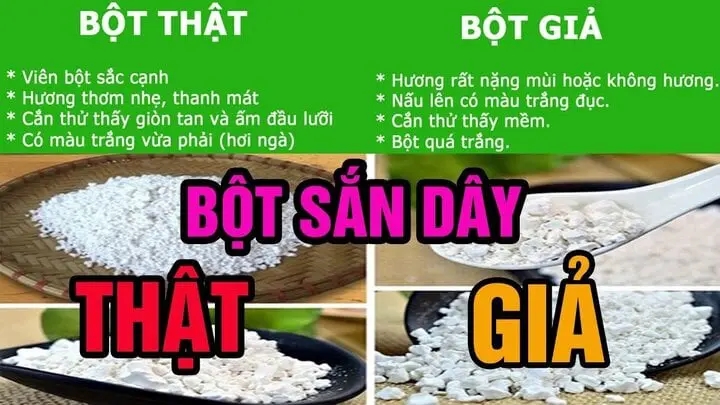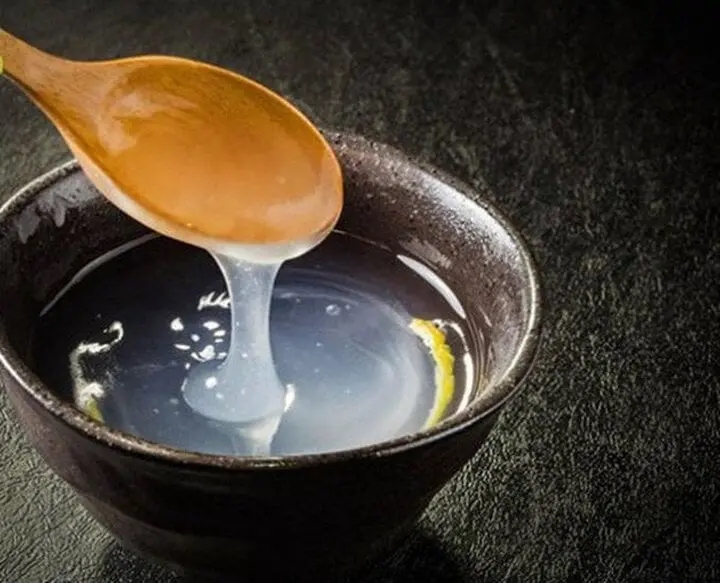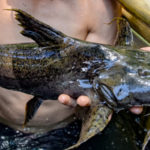Tapioca powder has the effect of cooling, detoxifying, and is very good for health, so the demand for consumption is quite high, especially in the summer. That’s why there are many types of tapioca powder on the market that are fake, of poor quality, and adulterated.
Distinguishing between real and fake tapioca powder
Before buying, you can identify genuine tapioca powder by using extremely simple methods.
Distinguishing with the naked eye
Genuine tapioca powder is a type of coarse, sharp-edged, pure white powder, with a distinctive natural aroma; dry powder, not moist. When you bite into it, genuine tapioca powder is crispy, dissolves quickly in the mouth, and gives a warm feeling on the tip of the tongue.
After the tapioca powder has dissolved, our tongues will sense the smoothness and absence of grit.

You can distinguish between real and fake tapioca powder by mixing a little with water. This method is effective and highly accurate. (Photo: Lorca.vn)
On the other hand, fake tapioca powder, mixed with impurities, is a mixture of blunt-edged, small granules, without the natural white color or aroma of tapioca, and feels soft when bitten.
Distinguishing by mixing with water
Put a little tapioca powder into a glass of water, then pour the water into another glass. If you see the water being poured clean, with no sediment at the bottom of the glass, then it is completely pure powder.
If you have more time, you can pour the cup of tapioca powder that has been dissolved into the refrigerator. After 3-5 hours, the powder will settle at the bottom of the cup. Pour out the water, and you will see that the powder is very difficult to scrape off and has an absolute white color, just like dry powder. This is the standard genuine powder.
Distinguishing by boiling

Boiling is a highly accurate method for distinguishing between real and fake tapioca powder. (Photo: Lemon8)
You take about 3 tablespoons of tapioca powder, 1 bowl of white water, 3 tablespoons of sugar, dissolve the mixture, then place it on the stove and cook for about 10 minutes, stirring continuously. When the powder is cooked, pour it into a bowl. If you see the powder deep at the bottom, then this is undoubtedly high-quality tapioca powder.
Distinguishing by taste
Simply, you can make 2 separate cups of the two types of tapioca powder and then try drinking them. The high-quality powder will certainly have a better taste, with the distinctive aroma of tapioca. Poor quality powders often have a strange taste, a musty or odorless smell.
Distinguishing by smell
When buying tapioca powder, you should not choose the type that has been infused with pomelo blossom because it is prone to mold or it is a fake product, so the seller infuses it with pomelo blossom scent to cover up the smell. You should buy powders that are truly dry and crispy to ensure their shelf life.
Notes when using tapioca powder
– Drinking cooked tapioca is still good for health. However, tapioca has a high cooling effect, so people with weak constitution or poor digestion may experience abdominal pain or diarrhea.
– Do not consume too much tapioca powder in one day. Tapioca powder contains a lot of starch. However, it also contains a lot of saponosides and a flavonoid called puerarin, so excessive use can have adverse effects on the body.
– Do not use too much sugar. When making tapioca, many people add sugar to make it taste better, but too much sugar can cause kidney disease and diabetes.
According to VTC News






































